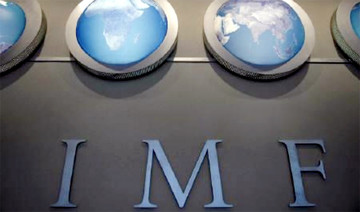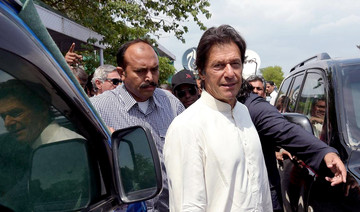ISLAMABAD: From cutting power subsidies to forcing currency devaluations that stoke inflation, the hard choices facing Pakistan as it seeks a bailout from the International Monetary Fund (IMF) pose a major headache for populist new Prime Minister Imran Khan.
Pakistani officials met IMF representatives this week in Bali and formally requested Islamabad’s 13th bailout since the late 1980s to give the economy breathing room, while they implement reforms aiming to end decades of boom and bust cycles.
On top of lending the nuclear armed state billions of dollars to avert another balance of payments crisis, the IMF is this time expected to push Islamabad much harder to enact structural reforms needed to rebalance the economy, and rein in spending that has boosted growth but blown out the government budget.
Talks with the IMF have been launched and managing director Christine Lagarde has already said she would require “absolute transparency” of Pakistan’s debts, including those owed to close ally China.
Any reforms prescribed by the IMF would threaten Khan’s lofty campaign promises, like his vow to create 10 million jobs and establish an “Islamic welfare state” modelled on the ideas first voiced by the Prophet Muhammad in the holy city of Medina.
Khan was elected in July with the support of many poorer Pakistanis desperate for a change in a nation where the illiteracy rate hovers above 40 percent, health care is shoddy, and joblessness or underemployment rife among the country’s 208 million people.
Creating 10 million jobs would require the economy to grow at 8 percent but that can only be achieved with economic shock therapy that in the short term will smother growth to far below the 5.8 percent achieved in the year to June, economists say.
“The path to Medina is full of thorns, not roses,” said one expert at an international donor agency, who declined to be identified as he is not authorized to speak on the issue.
“To get there, they have to go through these painful measures now.”
The IMF predicted this week Pakistan’s growth will slow to 4 percent in 2019 and fall to about 3 percent in the medium term.
A sharp increase in oil prices — Pakistan imports about 80 percent of oil needs — has contributed to a current account deficit that widened 43 percent to $18 billion in the fiscal year that ended June 30. The weakening Pakistan rupee also contributes to a rise in local energy prices.
On Wednesday, Khan blamed the previous government for the economic mess and urged Pakistanis to remain calm.
“I want to tell all of you to stay strong and not to panic. This is a very short period of time which will go away.”
“FEND FOR OURSELVES“
As an opposition leader, Khan vowed to never “beg” for money from the IMF and swept to power on an anti-corruption platform that was coupled with a promise to enact badly needed reforms, including widening the nation’s taxation net and reforming loss-making state-run enterprises.
But local and foreign investors have welcomed the bailout talks, saying Pakistan’s economy needs the IMF’s protective blanket because of rising oil prices and emerging markets turmoil. However, they also warned of tougher conditions compared to 2013, when Islamabad was given repeated wavers and avoided harsh reforms after receiving a $6.7 billion IMF loan.
“Better that we enter into a well-structured IMF program than try to fend for ourselves,” the Pakistan Business Council said in a statement.
In a nod to the IMF, which called the rupee “over-valued,” Pakistan’s central bank on Tuesday carried out its fifth devaluation since December, sending the rupee tumbling 7.5 percent to take its losses to 26 percent in the past 10 months. More devaluations are expected.
The bank has also hiked its main interest rate by 275 basis points since January, to 8.5 percent, and analysts say more rises are on the horizon.
The devaluations have stoked inflation worries and are putting extra pressure on debt servicing, which is a major concern for the new government. Debt service costs are set to account for 35 percent of the budget in the fiscal year to next June, according to forecasts from the previous government. Officials now expect the debt to GDP ratio to rise above 70 percent.
“We really have to get out of this debt dependency trap,” Muhammad Hammad Azhar, Pakistan’s state minister for revenue, told Reuters.
He said the government was considering the possible restructuring of some foreign loans but did not give details.
Khan’s government blames many of Pakistan’s current economic woes on the previous administration’s “strong rupee” policy, which rendered Pakistan’s exports uncompetitive. The central bank also burnt through currency reserves defending the rupee.
Reserves have plummeted 41 percent this year to stand at $8.3 billion, or about 1.6 months of import cover, despite China lending billions of dollars to Islamabad to prop up the currency.
CHINA LOANS
China has made Pakistan a flagship country in its vast Belt and Road infrastructure building program, pledging about $60 billion in financing for ports, railways and roads. But rising debt levels have caused Islamabad to cut the size of the biggest Belt and Road project by about $2 billion.
US Secretary of State Mike Pompeo has said there would be “no rationale” for an IMF bailout of Pakistan that pays off Chinese loans.
Khan’s administration had also approached China and Saudi Arabia, Islamabad’s other historical ally, for help to prop up the economy but they appear to have balked at coming to Pakistan’s rescue on their own.
Though the size of any bailout is not clear, Khan this week suggested Pakistan needs $10-12 billion. On top of the IMF, the World Bank and the Asian Development Bank are expected to lend money, as they did in 2013. China and Saudi Arabia may also contribute.
The IMF last week commended Pakistan for curbing gas and electricity subsidies, raising interest rates and devaluing the currency. But it warned that Islamabad needs to go even further in all those areas.
Pakistani officials say they are braced for tough measures but hope to expand the tax base and raise more revenue rather than rely purely on austerity to patch up a budget deficit which hit 6.6 percent of GDP in the fiscal year to end June. They also want to help further stimulate exports.
Azhar said Khan’s party was elected on a reforms agenda and would push through changes “irrespective of any IMF bailout.”
On Wednesday, Khan launched a program aiming to construct five million homes for the poor, a top campaign promise. But he didn’t explain how the government will pay for it. (Reporting by Drazen Jorgic Editing by Martin Howell and Raju Gopalakrishnan)
‘Path of thorns’: An IMF bailout set to impede Pakistan PM’s populist agenda
‘Path of thorns’: An IMF bailout set to impede Pakistan PM’s populist agenda
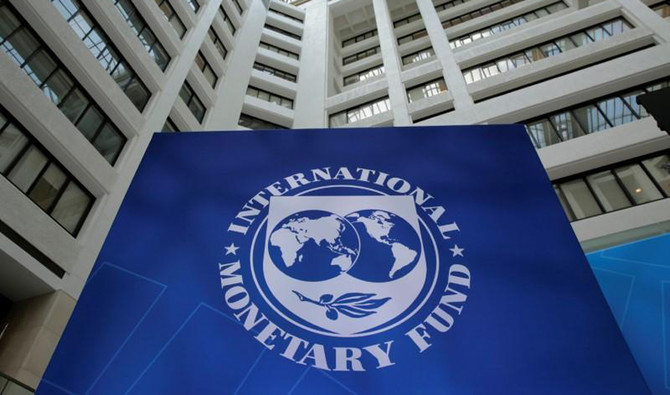
- IMF expected to push Pakistan to make some hard choices
- Measures likely to crimp new PM Khan’s social spending plans
Pakistan plans to improve medical education framework, resolve issues of locals studying abroad
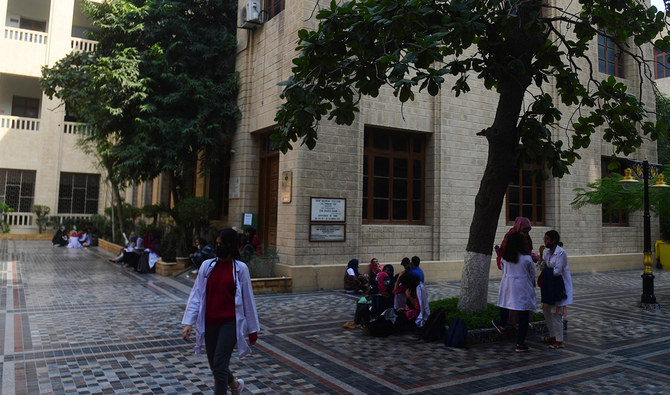
- The development came days after hundreds of Pakistani medical students returned from Kyrgyzstan following last week’s mob attacks
- Kyrgyz medical schools have over the decades become popular among aspiring doctors, thanks to affordable fees and living expenses
ISLAMABAD: Deputy Prime Minister Ishaq Dar on Friday called for improving regulatory framework for medical education in Pakistan to make it at par with international standards and to resolve issues faced by Pakistani students studying abroad, Pakistani state media reported.
The decision was made at a meeting of a government committee on medical education in Islamabad, which was presided over by Dar. The committee reviewed medical education system, including fee structures, and identified key areas for improvement to align it with global standards.
The development came days after hundreds of Pakistani medical students returned from Kyrgyzstan following last week’s mob attacks on residences of foreign students studying in the Kyrgyz capital of Bishkek over an earlier brawl between several Kyrgyz men and some Egyptian students.
Medical schools of Kyrgyzstan have over the last few decades become popular among aspiring doctors from India, Pakistan and some other Asian and Arab countries, in part thanks to relatively affordable fees and living expenses.
“The Deputy Prime Minister underlined the need to establish coordination mechanism between medical institutions and the public and private sector to ensure uniform high-quality education in all provinces,” the Radio Pakistan broadcaster reported.
“The meeting decided to constitute a sub-executive committee to review the existing TORs [terms of reference], synergize the regulatory bodies, streamline procedures for foreign students in Pakistan and uniformity in curricula.”
PM Shehbaz Sharif constituted the committee on medical education on May 20. The committee, which includes representatives of the medical community, education sector and government officials, was set up to reform medical education, improve health care standards and ensure highest quality of medical training for future generations of health care professionals.
“The sub-committee will prepare its report with the objective to ensure that medical graduates in Pakistan are equipped with the knowledge and skills required to meet contemporary health care challenges,” the report read.
Pakistan PM admires Ireland’s decision to recognize Palestine in phone call with counterpart
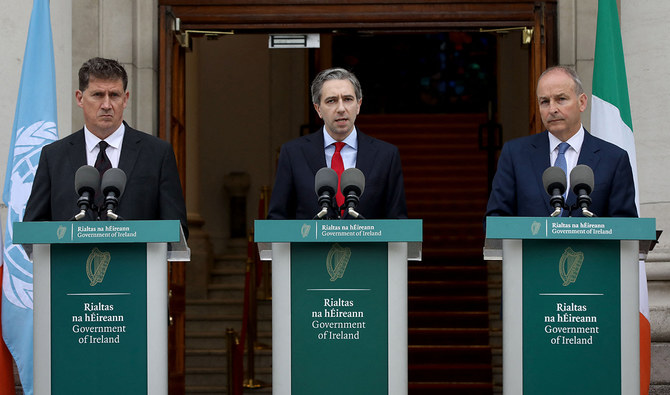
- Ireland, Spain and Norway this week said they would formally recognize Palestine as a state on May 28
- The additions have brought the total number of countries recognizing the Palestinian state to nearly 150
ISLAMABAD: Prime Minister Shehbaz Sharif on Friday held a telephonic conversation with his Irish counterpart Simon Harris, in which he admired Ireland’s recent decision to recognize Palestine as a state, Sharif’s office said.
The Pakistan prime minister felicitated his Irish counterpart on his assumption of office and remarked that his youth and dynamism would bring major changes to Ireland, according to a statement issued from Sharif’s office.
He noted that Pakistan had always advocated that a two-state solution, in accordance with relevant United Nations (UN) resolutions, was the only way to bring lasting peace to the Middle East.
“Ireland’s decision would send a message of hope and solidarity to the innocent Palestinians who were suffering Israel’s brutal atrocities,” Sharif was quoted as saying by his office.
“It would also go a long way in promoting the Palestine cause and would urge other countries to follow Ireland.”
The prime ministers of Ireland, Spain and Norway said on Wednesday they would formally recognize Palestine as a state on May 28, following recent recognitions by Barbados, Jamaica, Trinidad and Tobago and the Bahamas. The additions have brought the total number of countries recognizing the Palestinian state to nearly 150.
PM Harris said that Ireland had taken a principled decision in consultation with other European allies because the extent of Israel’s military action in Gaza could no longer be condoned in any way.
“The Irish felt that this decision was necessary to promote normalization in the occupied territories,” he was quoted as saying.
Sharif reaffirmed Pakistan’s strong commitment to the just struggle of the Palestinian people and lauded the decision of the International Court of Justice to order Israel to stop its assault on Gaza and Rafah.
Pakistan does not recognize the state of Israel and calls for an independent Palestinian state based on “internationally agreed parameters” and the pre-1967 borders with Al-Quds Al-Sharif as its capital.
In recent months, the South Asian country has repeatedly raised the issue of Israel’s war on Gaza, launched last October, at the United Nations through its permanent representative, Ambassador Munir Akram.
Pakistani delegation to seek investments during Kuwait visit by month-end
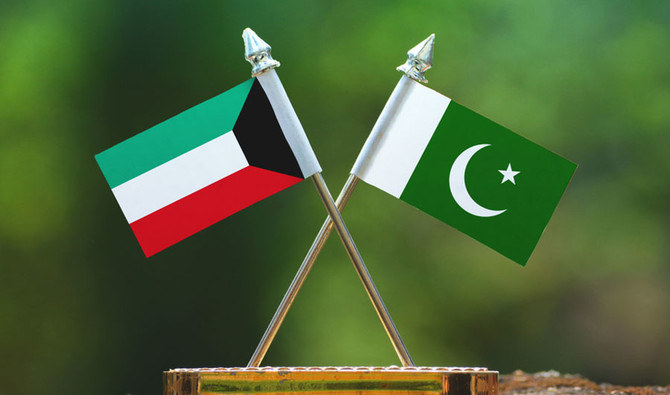
- The delegation will be led by Pakistan’s investment minister Abdul Aleem Khan and hold meeting with top officials
- Khan says the visit will also help create greater employment opportunities for Pakistani workforce in the Gulf state
ISLAMABAD: A high-level Pakistani delegation is expected to visit Kuwait by the end of the month to strengthen bilateral cooperation and highlight business opportunities in the country amid renewed efforts to attract investment from the Gulf state.
Last year, the two countries agreed to deepen their economic and investment ties during the visit of interim prime minister Anwaar-ul-Haq Kakar to the Arab state in late November. The visit was billed as a significant step in enhancing the relationship between the two countries, with the signing of various memoranda of understanding aimed at boosting cooperation in fields such as manpower, information technology, mineral exploration, food security, energy and defense.
Kakar’s visit to Kuwait came just a few months after the country established the Special Investment Facilitation Council (SIFC), a civil-military hybrid body designed to oversee foreign financing with a specific focus on the Gulf region.
The upcoming visit of the Pakistani delegation, led by Federal Minister for Board of Investment, Privatization and Communications Abdul Aleem Khan, was announced in an official statement, although the exact dates were not specified.
“During the visit to Kuwait, there will be progress in providing employment to more workforce from Pakistan, especially health professionals and skilled labor,” Khan was quoted as saying in the statement.
“Pakistan will increase cooperation [with Kuwait] by taking on board its export companies for dairy farming, meat products, rice and other food items and move forward through accelerated measures,” he added.
The minister expressed optimism that the visit would mark the beginning of a new era of mutual cooperation, improvement in economic affairs and investment, for which the relevant departments were making preparations.
He presided over a meeting about the visit and told participants that Kuwait’s envoy had also been taken on board while making all necessary arrangements.
The delegation is expected to hold meetings with top officials of the Gulf country to discuss trade and business activities between the two countries.
Can New York hit cricket for 6? These guys think so
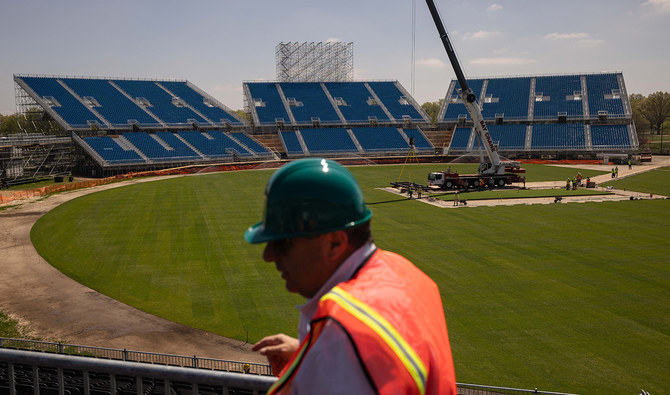
- The centuries-old English game has a feverish following throughout much of the world
- But US, partial to American football, basketball and baseball, has been stubborn holdout
EAST MEADOW: In the shadow of New York skyscrapers a field of dreams emerges, but it is not a baseball diamond. It’s for another bat-and-ball sport — cricket — that supporters are betting will finally bowl Americans over.
The centuries-old English game has a feverish following throughout much of the world, but the United States, long partial to American football, basketball and national pastime baseball, has been a stubborn holdout.
That may change early next month when the United States has its moment in the cricket sun, co-hosting the Twenty20 World Cup — the championship series for a shortened format of cricket.
The temporary new stadium, financed entirely by the International Cricket Council, the sport’s global governing body, will host eight tournament matches including the June 9 headliner, a potentially epic clash between powerhouses India and Pakistan, two of the sport’s biggest rivals.
Some 10 miles (16 kilometers) east of New York, a forest of metal beams supporting 34,000 bleacher seats rises from Long Island’s Eisenhower Park, a site the ICC chose after its earlier plan in the Bronx fell through.
It is not quite the gracious as Lord’s cricket ground in London, but Nassau County International Cricket Stadium will be in the spotlight shortly — thanks to a swift green light from local authorities.
“The world is coming right here to Nassau County. You’re going to have kings and princes and big dignitaries,” beamed the county’s deputy commissioner of parks, Michael D’Ambrosio.
“A lot of people are very envious and jealous that we got this,” he told AFP, noting the tournament’s massive global viewership.
The ICC, for its part, is investing big in the sport’s future in the US, particularly the New York region, home to several hundred thousand people with links to cricket-playing countries, notably India and Pakistan.
The India-Pakistan showdown is already sold out, with tickets now topping $1,000 each online.
But once the stadium is dismantled in July, local cricket will return to its struggling state. Despite having around 10,000 players, the sport has no dedicated stadium in New York.
“Cricket is growing, but the infrastructure — that’s where the fight is,” lamented Ajith Shetty, president of the Commonwealth Cricket League (CCL), the region’s premier cricket grouping.
New York does field a team in Major League Cricket, the professional league launched last year, and plays on dedicated pitches — in Texas and North Carolina, where all MLC matches occur to control costs.
“We are exploring opportunities to create a permanent venue close to our loyal fan base,” a spokesperson for defending MLC champions MI New York told AFP.
Meanwhile CCL players lug a 500-pound (225-kilogram) mat from park to park, which acts as the “pitch,” the rectangular area at the center of a cricket field.
“No other sport has to put in this much work, only cricket in New York. They make us suffer,” said Shetty, an Indian-born entrepreneur.
“New York used to be a Makkah of cricket,” he added. But while conditions have stagnated in the Big Apple, other states have improved, especially Texas.
Houston is where team USA stunned Bangladesh on Thursday to sweep their three-match T20 international series ahead of the World Cup.
Backed by local entrepreneurs, some CCL clubs pay players thousands of dollars per year, although not enough to quit their day jobs.
Waqas Ashiq, who plays for Long Island United CC and recalls the struggles back when the team started in 2008, sees the glass half full.
“It’s been a long time coming,” he said before strolling on to the field to bat.
“I’m hopeful that with this World Cup coming, people get their interest piqued a little bit.”
According to Shetty, the entrepreneur, the ICC is keen to invest in US youth development, particularly in light of cricket returning to the Olympics, at the 2028 Games in Los Angeles. Schools are also showing interest.
The challenge now, agreed Ashiq, in addition to the quest for a permanent stadium, is involving the next generation — children of the cricket-loving immigrants who have made New York their home.
“That’s the only way to grow the sport and make sure it’s secure for the next 10, 20, 30 years.”
Pakistan and China move forward on $6.76 billion railway line project amid increased security measures

- Minister Ahsan Iqbal says ML-1 project is now ready for the bidding process among eligible Chinese companies
- PM Sharif also meets Chinese businessmen, asks them to set up industries in special economic zones under CPEC
KARACHI: With an emphasis on improving the security of Chinese workers in Pakistan, officials in Beijing and Islamabad held the 13th Joint Cooperation Committee (JCC) meeting online on Friday, agreeing to proceed with the ML-1 railway project estimated to cost over $6 billion.
The JCC meeting, which focused on joint energy and infrastructure development initiatives under the multibillion-dollar China-Pakistan Economic Corridor (CPEC), was convened after the March 26 suicide attack that killed five Chinese engineers and their local driver en route to the under-construction Dasu dam.
Briefing the media about the decisions made during the meeting, Pakistan’s planning minister Ahsan Iqbal said Chinese security concerns were discussed during the talks.
“Security issues were discussed in the meeting and China was briefed on improving security,” he said, adding that Pakistani authorities had raised a special force to ensure the safety of CPEC projects.
The Chinese nationals in Pakistan have been targeted by various militant factions, with a significant number of attacks coming from Baloch nationalists who aim to push Beijing out of the mineral-rich Balochistan province.
Pakistan’s top economic body on Thursday approved $2.5 million in compensation for the families of the Chinese workers killed in the March 26 Dasu attack.
Iqbal mentioned that both sides decided to initiate more projects apart from those carried out under the CPEC umbrella, adding: “We will jointly improve the security for these projects.”
He also informed the two countries agreed to start the mega ML-1 railway project focusing on the dualization of the existing railway network, built in the late 19th century, and the overall upgrading of tracks connecting the port city of Karachi to Peshawar.
“I am pleased to inform you that Pakistan has made significant progress on the Pakistan Railways Mainline-1 project,” the planning minister said. “The re-modified PC-1 [project feasibility] has been approved with a cost of $6.76 billion in two phases.”
“The project is now ready for the bidding process among eligible Chinese companies,” he added. “We request that the bidding process should start immediately in view of the poor deterioration of the railway track.”
Iqbal also provided details of the CPEC projects that have been completed so far.
“It is heartening to note the steady progress CPEC has made since its inception in 2013,” he said. “In the energy sector, we have successfully completed 16 projects, with a generation capacity of 8,020 MW [megawatts], along with two coal mines and a +660 kV HVDC [Kilovolt High Voltage Direct Current] transmission line.”
He added that the 884 MV Suki Kinari hydropower project worth $1.707 billion was still under construction and expected to be commissioned by November 2024.
“Three power projects, including two hydel (Azad Pattan 700 MW and Kohala 1124 MW) and one coal-based (Gwadar) with a generation capacity of 2124.7 MW worth $4.157 billion, are at an advanced stage,” he continued.
The minister maintained concrete progress on the next CPEC phase would emerge after Prime Minister Shahbaz Sharif’s visit to China, expected in the first week of June.
The two countries have closely collaborated since the launch of the joint corridor project. Sharif met representatives of several Chinese companies on Friday, noting that bilateral relations between the two states were further strengthening.
He urged Chinese companies to establish their industries in the special economic zones under CPEC by developing business-to-business relations, particularly inviting Chinese entrepreneurs in the textile sector to benefit from the opportunities in Pakistan.
Speaking to Arab News, Ammar Habib Khan, a senior research economist, acknowledged China’s financial assistance to Pakistan while suggesting that Islamabad wanted Beijing to soften its stance on restructuring about $15 billion in loans, mainly extended for power and other infrastructure projects.
“The debt restructuring of about $15 billion, including those of the power sector, will provide Pakistan a breathing space and could lead to a reduction in electricity prices,” he said.


